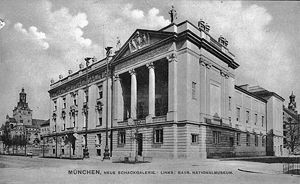
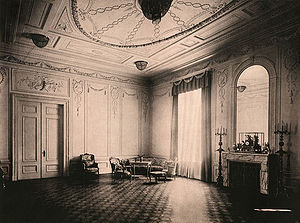
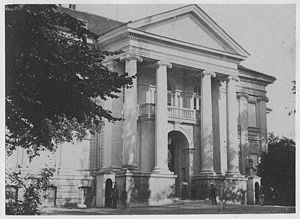
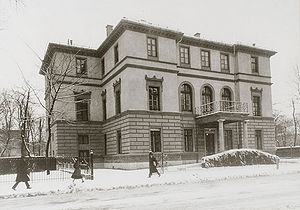
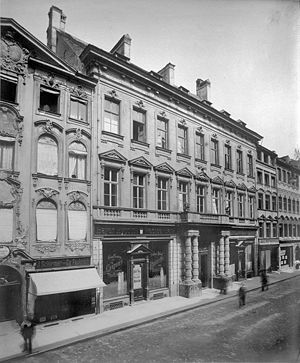
Permanent diplomatic representations were not established in Munich until the 18th century, beginning with the Emperor's legation in 1745 and the Apostolic Nunciature in 1784/85. After a peak in the Vormärz, many states started to withdraw their envoys from Munich after the revolution of 1848. During the First World War, most of the embassies closed and were not re-opened after the end of the war due to the loss of Bavaria's foreign policy competencies. Only France and the Vatican maintained representations in Munich in the interwar period.
Definition of legation
In contrast to consular authorities, which are merely administrative in nature, legations are diplomatic, i.e. political authorities. Envoys are representatives of their sending state under international law and represent it in all aspects. They have diplomatic immunity as extraterritorial persons. They remain subject to the laws of their sending state and are therefore not touched by domestic jurisdiction. Since the Congress of Vienna in 1815 (supplemented by the Aachen Protocol of 1818, revised in 1961), the four classes of diplomatic representatives have been ambassadors, envoys, minister residents and chargé d’affaires. They are accredited directly by the receiving state's government.
Beginnings of diplomatic representations in Munich since the 16th century
The beginnings of diplomatic representations in Europe date back to the end of the Middle Ages. The first foreign representations in Munich, however, which include the short-lived Southern German nunciature and the imperial legation that followed soon after, were only established around the threshold of the 16th and 17th centuries.
Ultimately, the development towards a qualified legation system in Munich took until the 18th century. It was only at that time that diplomatic representations became increasingly institutionalised, prompted by the impetus of the Enlightenment. In addition to the emperor's legation, which had been continuously occupied only since 1745, and the Münchner Nuntiatur founded in 1784/85, other states, such as Prussia, Saxony, France and the British crown, now also sent diplomatic representatives to the Munich court.
Peak of the legation system
The legation system in Munich experienced its heyday in the first half of the 19th century. One main reason for this was, besides the territorial reorganisation by the Congress of Vienna, the advancing modernisation of the states, which also led to a further professionalisation of the legation system.
Among the numerous new diplomatic representations at the Munich Court were German states such as Kurhessen (year of establishment: 1805), Hesse (1806), Baden (1806), Nassau (1825), Hannover (1832), Saxony-Coburg-Gotha (1836) and Saxony-Meiningen (1845) on the one hand. On the other hand, powers such as Russia (1808), Sardinia (1816), Spain (1818), Belgium (1848), Mexico (1864) and Italy (1865) sent their representatives to Munich as well. Great Britain resumed its diplomatic relations in December 1813, after they had been interrupted, explicitly referring to its "great satisfaction" with the Treaty of Ried between Bavaria and Austria on 8 October of the same year, in which Bavaria had joined the coalition against Napoleon (1769-1821).
Indirect representations
Luxembourg's interests were represented by the Russian legation from 1869, and Liechtenstein's interests by the Austro-Hungarian legation from 1880 onward. Prussia's legation also represented the North German Confederation after January 1870 and was renamed accordingly. Some states based their representatives in other places, yet accredited them at the Munich Court, too. These included the Netherlands (1814, seat: Berlin), Sweden (1828, Vienna), Greece (1833, subsequently temporarily vacant, Berlin or Vienna), the United States of America (1867, Berlin), Switzerland (1867, Berlin) and the Kingdom of Hawaii (1868, Karlsruhe).
Start of the reduction in legations
Although the foundation of the German Reich in 1871 must be seen as a turning point in the history of the foreign legations in Munich, the dismantling of representative offices began as early as 1848. The Munich legations of states such as Nassau (year of abolition: 1848), Saxony-Meiningen (1848), Saxony-Coburg-Gotha (1850), Hannover (1866) or Kurhessen (1866) enjoyed but a short history. Hesse decided to abolish its diplomatic mission in 1882, whereas Baden had already taken this step in 1871, "since the economic and commercial interests of the state and its citizens were sufficiently protected by the diplomatic and consular agents of the Reich." When the Grand Duke of Baden, Friedrich I (1826-1907, ruled 1856-1907) reoccupied the post of ambassador in Munich in 1895 against the will of the state parliament, this consequentially caused considerable political upheaval in Baden.
Legation in the empire 1871-1918
With the foundation of the German Empire in 1871, foreign policy became the empire's remit. However, the German federal states retained independent foreign policy rights in their areas of competence (in particular economy and culture). For this reason, not all states withdrew their diplomatic missions from Munich after 1871. Some representations of foreign states such as Sweden turned their backs on the Bavarian capital (1872), but instead accredited their Berlin envoys to the Munich court. Belgium also decided to take this step nine years later, after its legation was abolished in 1872.
On the eve of the First World War in 1914, there were eight foreign legations in Munich (France, England, Russia, Italy, Austria-Hungary, Prussia, Saxony, Baden) in addition to the nunciature. Seven other states were represented there by their Berlin missions (Belgium, Greece, Spain, Sweden, the Netherlands, Switzerland, Persia).
Legal uncertainty in the Weimar Republic
Many of the foreign legations in Munich closed their doors during the First World War. After the war, there was no reason for most of them to reopen. Articles 6 and 78 of the Weimar Constitution of 11 August 1919 reserved the regulation of Germany's foreign policy relations and the cultivation of relations with foreign countries "exclusively" to the Reich government.
However, the legal situation was by no means clear-cut. Bavaria and Saxony had in fact voluntarily renounced their own foreign missions in an agreement with the Reich government in January 1920. The status of the German states' passive legation law remained unclear, however. The question of the states' rights to host foreign legations on their own territory and to maintain political contacts with them was answered differently by different authorities at different times – even within the Bavarian state government. In some cases, the legations were seen as a way of emphasising Bavarian statehood in the face of the Reich's push for unitarization.
Bavarian diplomatic mission efforts
In view of this legal uncertainty, Bavaria made repeated efforts in the early post-war years to establish an Austrian legation in Munich. Vienna, however, did not respond to this request out of consideration for the interests of the German government and the Allies. Belgium, on the other hand, itself approached the Bavarian government in 1920 with the proposal to revive diplomatic contacts with Bavaria, which had been interrupted during the war, for which purpose the Belgian envoy in Berlin was to be accredited in Bavaria. In this case, though, the state government refused, referring to Article 78 of the Reich Constitution.
The end of legations in Munich
The end of the Imperial and Royal Austro-Hungarian legation in Munich in 1919 was deeply regretted by the Bavarian government (Austria was still represented by its envoy to the Bavarian government in Berlin until 1920). When, on the other hand, France revived its legation in Munich, which had been closed at the outbreak of the war, in 1920 without having first obtained an agreement from the Bavarian government this caused considerable upset. Despite hostility, not least from the general population, Paris maintained its legation and did not even comply with the will of the National Socialist Reich government to convert the representation into a consulate general in 1933. The former enemy’s representation therefore lasted until the start of the Second World War, consequently closing its doors as the last diplomatic representation in Munich. The nunciature, which was rich in tradition and formally enjoyed a special position due to the codex iuris canonici, had already ceased to exist prior to this (1934). However, the nunciature had lost a great deal of its importance anyway, after an Apostolic Nunciature was established in Berlin in 1920 and Eugenio Pacelli, later to become Pope Pius XII (1876-1958, Pope 1939-1958), left Munich in 1925 for the Reich capital.
References
- Irmgard von Barton von Stedman, Die preußische Gesandtschaft in München als Instrument der Reichspolitik in Bayern von den Anfängen der Reichsgründung bis zu Bismarcks Entlassung, (Miscellanea Bavarica Monacensia 2) München 1967.
- Sylvia Krauß, Die politischen Beziehungen zwischen Bayern und Frankreich 1814/15-1840 (Schriftenreihe zur bayerischen Landesgeschichte 87), München 1987.
- Andrea M. Müller, Die französische Gesandtschaft in München in den Jahren der Weimarer Republik. Französische Politik im Spiegel der diplomatischen Berichterstattung (Miscellanea Bavarica Monacensia 184), München 2010.
- Alois Schmid (Hg.), Die Berichte der diplomatischen Vertreter des Kaiserhofes aus München an die Staatskanzlei zu Wien während der Regierungszeit des Kurfürsten Max III. Joseph. 1. Band: 1745-1746 (Quellen zur Neueren Geschichte Bayerns 2), München 2000.
- Michael Weigl, Das Bayernbild der Repräsentanten Österreichs in München 1918-1938. Die diplomatische und konsularische Berichterstattung vor dem Hintergrund der bayerisch-österreichischen Beziehungen, Frankfurt am Main 2005.
- Bernhard Zittel, Die Vertretung des Hl. Stuhles in München 1785-1934, in: Der Mönch im Wappen. Aus Geschichte und Gegenwart des katholischen München, München 1960, 419-494.
Sources
The history of the foreign legations in Munich has so far only been researched selectively. The article, particularly as it pertains to the 19th century, is thus based on a first evaluation of the relevant sources in the Bayerische Hauptstaatsarchiv (Bavarian Main State Archive) by the author. All given dates are therefore subject to possible corrections as a result of further research.
- Anton Chroust (Bearb.) : Gesandtschaftsberichte aus München 1814 – 1848. Erste Abteilung: Die Berichte der französischen Gesandten (Schriftenreihe zur bayerischen Landesgeschichte 18, 19, 21-24), München 1935-1937 .
- Anton Chroust (Bearb.) : Gesandtschaftsberichte aus München 1814-1848. Zweite Abteilung: Die Berichte der österreichischen Gesandten (Schriftenreihe zur bayerischen Landesgeschichte 33, 36-38), München 1939-1942.
- Anton Chroust (Bearb.) : Gesandtschaftsberichte aus München 1814-1848. Dritte Abteilung: Die Berichte der preußischen Gesandten (Schriftenreihe zur bayerischen Landesgeschichte 39-43), München 1949-1951.
Further Research
External Links
Related Articles
- Bavarian Legations (19th and 20th century)
- Föderalismus
- Reservatrechte
- State Visits (after 1945)
- Staatsministerium des Äußern
- Vertretung des Freistaates Bayern bei der Europäischen Union
Botschaften
Cite
Michael Weigl, Foreign Legations in Munich, published 07 August 2006, English version published 21 February 2024; in: Historisches Lexikon Bayerns, URL: <https://www.historisches-lexikon-bayerns.de/Lexikon/EN:Foreign_Legations_in_Munich> (21.12.2025)
